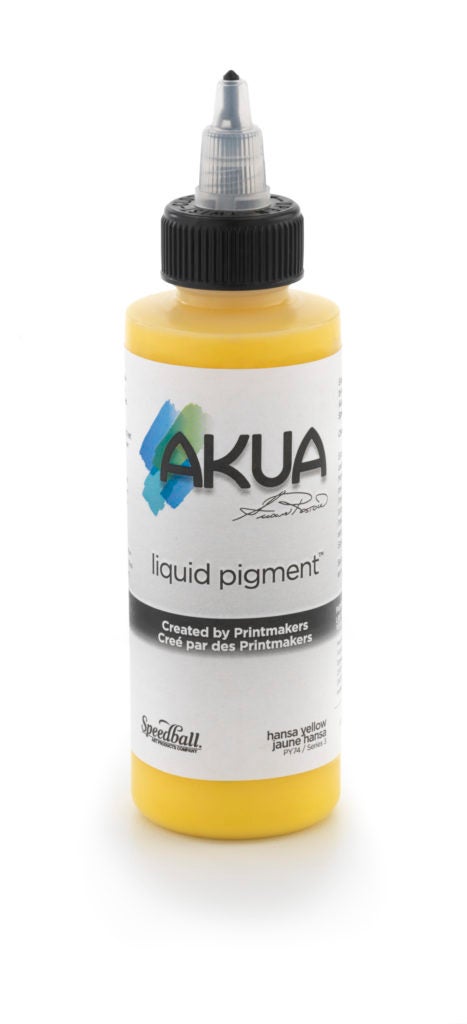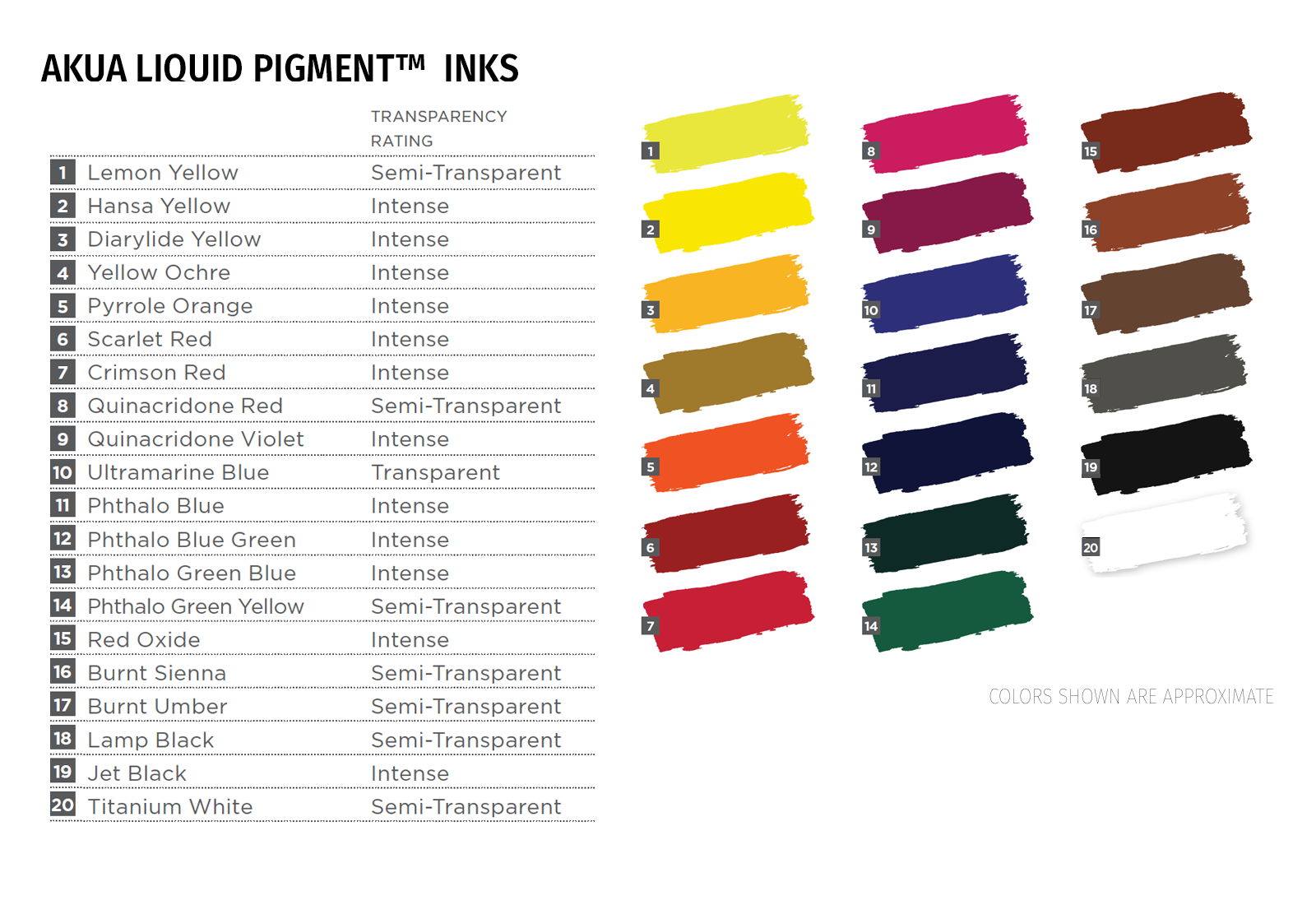Akua Liquid Pigment Inks
Home » Our Product Lines » Printmaking » Akua Printmaking » Akua Inks » Akua Liquid Pigment Inks
Akua Liquid Pigment® is made with the highest quality, lightfast pigments, and does not contain any chalk or suspending agents. Colors are exceptionally strong, yet transparent and are ideal for multi-layer printing. In addition, the high pigment load and wide selection of colors makes it great for tinting Akua Intaglio®, Akua Transparent Base or other printmaking inks. Akua Liquid Pigment’s rich working consistency is excellent for all monotype techniques and its ability to stay wet on the plate for an extended period of time provides artists with many hours to create an image. All colors carry the AP Seal and clean up easily with soap and water.

GET INSPIRED
Looking for some creative inspiration on how to incorporate Akua Intaglio into your creative process? Select from the links below to view step-by-step instructional videos or visit our Akua Gallery to see a range of finished works.
-
Akua Liquid Pigment Literature Downloads
For SDS information, please visit SDS/MSDS Information.
-
Frequently Asked Questions
- What is the difference between water-based and water-soluble ink? The term “water-soluble” is used to describe substances that dissolve in water. The term “water-based” implies that water is among the ingredients in the inks' formulation.
Are Akua Inks water-based or water-soluble? Akua Intaglio Ink is NOT water-soluble. The Intaglio process requires printing on damp paper. If the ink were soluble, then it would not hold up to the challenge of printing on damp paper. A non-water-soluble ink will offer a sharper image. If you were to mix water into Akua Intaglio ink, it would not dissolve, it would stiffen up. Soap is necessary to dissolve Akua Intaglio Ink. Akua Liquid Pigment IS water-soluble. It prints best on dry paper and cleans up with just water. However, small amounts of Akua Liquid Pigment added into Akua Intaglio Inks or Akua Transparent Base would eliminate Liquid Pigment’s water-solubility. Both Akua Intaglio and Akua Liquid Pigment have water among their bases' ingredients. - What are the advantages of Akua Inks? Akua Inks are high-quality, pigmented inks. They offer the artist the opportunity to work in a safer, fume-free studio without sacrificing the quality of their methods and materials. Akua Inks clean up quickly and easily with soap and water, not hazardous solvents. The ink never hardens or skins, meaning you don’t waste ink and no longer have to use hazardous anti-skin sprays. Akua Inks will not dry on a non-absorbent surface, meaning you never have to clean your palette or worry about damaging tools or plates with dried ink. The fact that Akua Ink doesn’t dry on the slab eliminates the need to clean up right away.
- What are the differences between Akua Liquid Pigment and Akua Intaglio Inks? Akua Intaglio is a thick ink and comes in a jar. If you are accustomed to working with etching or relief inks, this product may feel more familiar to you. It is ideally-suited for Intaglio/Etching, Monotype, Gel Printing and Collagraph. It is also suitable for use when relief printing and letterpress, although many artists pair the Intaglio ink with Akua modifiers to suit their process specific to these techniques. Visit the Akua Modifiers page to learn more. Akua Liquid Pigment is a liquid ink and comes in a bottle. If you are accustomed to working with watercolors, this product may feel more familiar to you. Akua Liquid Pigment is ideal for use with Monotype, Japanese Woodblock and Gel Printing. Click here to see the Akua Inks Comparison Chart.
- Are Akua Inks compatible with Gel Printing Plates? Speedball Gel Printing Plates were specially-formulated for use with printmaking inks, and are ideally-suited for use with Akua Intaglio and Akua Liquid Pigment Inks. Akua Intaglio Inks are also compatible with other brands of gel printing plates, but cannot be used with homemade gelatin plates as these plates will resist the ink due to the soy base. Akua Liquid Pigment Inks may be used both with competitive gel printing plates and homemade gelatin plates.
- Oily blooms/halos are appearing on my paper after printing. What is causing this? The interaction between ink and paper may be the cause of this issue and/or the ink application for the print is too heavy. Thin, Japanese-type papers may be particularly susceptible to this. Akua Liquid Pigment is recommended for use with these types of papers due to its binder type. Depending on the specific process utilized, Akua Liquid Pigment may be used directly from the bottle or mixed with wheat paste or methylcellulose (the amount of each depends on desired color, paper used and the environment’s humidity). Adding wheat paste or methylcellulose to Akua Liquid Pigment will make the ink dry more quickly. If a greater open time is needed, simply add Akua Retarder to the ink.
- The ink on my print is too light when it dries. How can I correct this? The following may be related to this issue:
- The ink needs to be more thoroughly stirred in the jar before using.
- The paper/ink interaction is not ideal. Try another type of paper.
- The paper may be too wet (soak less, blot more).
- The plate may be over-wiped (try using an inky Akua Wiping Fabric).
- The ink dries too dark on my print. How can I correct this? The following steps are suggested to eliminate this issue:
- Add Transparent Base to the ink to reduce the color intensity.
- Paper may be too wet (soak less, blot more).
- Try different papers. The paper/ink interaction is not ideal.
- There is too much plate tone on my print. How can I decrease it? The following steps are suggested to decrease plate tone:
- Print on dry paper.
- Wipe plate more thoroughly prior to printing.
- Do a final wipe with clean Akua Wiping Fabric.
- Lightly coat wiping cloth with Magnesium Carbonate.
- Clean selected areas with cotton swabs.
- My prints are drying blotchy. What can I do to keep this from happening? Please see the troubleshooting points below:
- Change blankets.
- Dampen the paper more evenly.
- Avoid touching the inked surface of the plate and transferring fingerprints.
- When will the print be dry enough to frame under glass? As long as the print is not touching the glass, the print can be framed under glass almost immediately. Unlike traditional oil-based inks, Akua Inks dry by absorption, not evaporation; therefore, they will not leave a “film” on the glass as they dry. If the glass will be touching the print, let the print dry for at least 24-48 hrs. It is recommended to lay a piece of Newsprint on top of your print as it dries (with something heavy on top of it, like a book, if possible) to help pull up any residual ink that was left sitting on the surface. Residual ink left on the surface will not dry, as it was unable to fully absorb into the paper. This happens when one applies too much ink.
- Where can I find information regarding the specific pigments used in the individual colors? Specific pigment information can be found by clicking here.
- Can I print on fabric with Akua Inks? Printing on fabric with Akua Inks can be done, but must be experimental as we do not have any formal testing for this specific process. Akua Inks do stain, although they do not contain dyes, so they cannot be treated as a dye. The inks will not be permanent on fabrics, and should not be used on projects that will be handled often or washed. Additionally, the inks cannot be heat set to make permanent.
- Can I use a sealer after printing with Akua Inks? If you are extremely concerned with rub-off and are comfortable with using spray fixative, a clear, acrylic spray gloss can be used with Akua Inks. To adequately “seal” your print, apply approximately three very thin coats of spray gloss. It is not recommended to use a matte or satin finish spray fixative, as it will alter the appearance of the inks’ color.
- Can I use Akua Inks for letterpress? Akua Intaglio Inks can be used for letterpress printing. Visit the “Frequently Asked Questions” section of the Akua Intaglio Inks’ page to learn more.
- What is the difference between water-based and water-soluble ink? The term “water-soluble” is used to describe substances that dissolve in water. The term “water-based” implies that water is among the ingredients in the inks' formulation.

